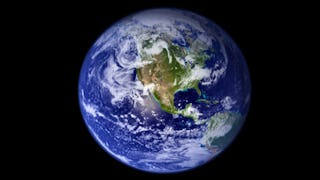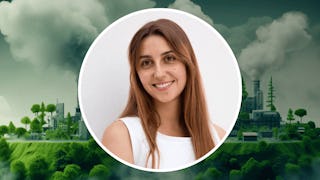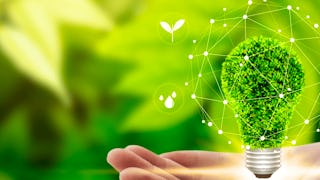In this course, learners begin with a macro-level view of the current state of the world and touch upon topics such as climate change, plastic pollution, social inequity, and the economic systems that got us to where we are today. Learners investigate how such an economy cannot sustain itself and the need for a rapid transition to something different. We define sustainability, the meaning of sustainable development, and the United Nations' Sustainability Goals.



The Sustainability Imperative

Instructor: Michael J. Readey, Ph.D.
8,014 already enrolled
Included with 
(63 reviews)
Recommended experience
What you'll learn
Define sustainability and sustainable development
Discuss with friends, family, and work colleagues the imperative to move to a more sustainable way of life
Explain the role of energy production and carbon emissions and the necessary transition to carbon-free energy technologies
Apply simple carbon footprint assessment techniques to demonstrate the environmental impact of their personal energy consumption patterns
Details to know

Add to your LinkedIn profile
4 assignments
See how employees at top companies are mastering in-demand skills


Earn a career certificate
Add this credential to your LinkedIn profile, resume, or CV
Share it on social media and in your performance review

There are 6 modules in this course
In this module, we set the stage for the entire course. You will learn about the current state of the world, ranging from climate change and its consequences to ocean acidification. We then see how climate change and our own direct impacts such as deforestation are affecting the plants and animals that share this planet with us. We then turn our attention to the problem of plastic pollution, and how this is rapidly becoming a crisis of monumental proportions. Some have even suggested that we humans are changing the planet in so many ways that we’re entering a new geological epoch referred to as the Anthropocene. Of course, sustainability is more than just an environmental issue. To this point, we will discuss the social inequity across the globe, and how those at the bottom of the economic pyramid often suffer the most. While this may seem a rather depressing start to the course, we need to understand the magnitude of the challenges facing us and our current understanding behind them if we are ever going to get to a more sustainable future. With that in mind, we conclude with some uplifting initiatives pioneered by scientists, environmentalists, entrepreneurs and often just passionate individuals that want to make a difference.
What's included
9 videos2 readings1 assignment2 discussion prompts
In this module, you will learn why the climate is changing using the latest science-based understanding. We start with an explanation of carbon emissions, the greenhouse gas effect, and the carbon cycle. You will learn where these emissions are coming from, notably the production of energy, transportation, and agriculture to name a few. We then discuss organizations such as the International Panel on Climate Change (IPCC) and the models predicting future scenarios about climate impacts based on carbon emissions and our actions to reduce them (or not). Understanding these scenarios, you will see why 2030 is such an important milestone to transition from fossil fuels to more renewable resources. You will learn that many of our global challenges such as climate change are a result of an intense focus on never ending economic growth pursued by most nations around the world. Competition among businesses is a good thing. Yet without accounting for costs known as “externalities”, you will see how business growth readily leads to social inequity, natural resource depletion and environmental degradation. We finally introduce the concepts of sustainability and sustainable development, and how the UN has defined several “Sustainable Development Goals” for the future. We introduce the “IPAT” equation and relate that to what happens as the planet continues to grow to 9+ billion people, all wanting the same quality of life as that of so-called developed nations.
What's included
7 videos1 assignment
In this module, we focus our attention on the largest source of greenhouse gases on the planet, the consumption of fossil fuels such as coal, natural gas and oil. Specifically, we show how coal and natural gas are used to generate electricity and why oil is used in transportation, and the economic factors of why their use is so widespread around the world. You will learn about coal, the driver of the industrial economy for the past 250 years and why its use is actually decreasing these days, being replaced by natural gas as the primary fuel for power generation. You’ll learn why natural gas has a lower carbon footprint, thus leading to its characterization as a “clean fuel” and why some believe this is a necessary “bridge fuel” as we transition to more renewables. Finally, we revisit the climate change models from Module 2 and see what happens under different scenarios of energy production. The world’s population is increasing, and people need access to energy. You will understand how a “status quo” approach to future power generation leads to irreversible temperature increases, and why this is the “existential threat” we often hear about.
What's included
6 videos2 discussion prompts
In this module, we look at how energy is produced today. We start by understanding what we mean by “fossil fuels”, and where they come from. We then turn our attention to how we get electricity by burning them in a power plant. We’ll go into how a power plant works, so you can understand what the coal or natural gas is actually doing in the process of producing electricity. We then examine the relationship between how electricity is produced and the quantity of greenhouse gases that are created. This will be a useful thing to know as we evaluate our own energy usage, and therefore our own contributions to greenhouse gases. Any discussion of energy needs to include nuclear energy. Today this remains is a highly controversial issue, as there are many pros and cons to nuclear power plants. We’ll go over a few of those so you can make up your own mind if nuclear energy needs to be in the mix for the future. Finally, we end on a bright note illustrating that many positive changes are taking place when it comes to transitioning to net zero power generation technologies - technologies that are inherently more environmentally friendly and even less expensive than the traditional fossil fuel technologies used today.
What's included
6 videos1 assignment1 discussion prompt
In this module, you will learn about renewable energy technologies such as solar power, wind power, and hydroelectric power. In Module 3, you learned why the transition to renewables is imperative. You’ll see in this module that the transition is already underway, in part because of lower carbon emissions but also because it makes financial sense; the innovations and manufacturing economies of scale make renewables the lowest cost source of energy today and even more so in the near future. You’ll then learn how transitioning to renewables is not the complete answer; we also need energy storage for when the sun doesn’t shine or wind doesn’t blow. Yet energy storage technologies have also made considerable advances in the past decade. For instance, you’ll see how batteries designed for EV’s have enabled cost-effective energy storage for grid applications. We’ll discuss how the transition to renewables is expected to take place, and the timelines for how long it will take. Finally, you’ll learn about new technologies that are getting a lot of attention these days, from electricity generated by ocean tides to renewable biogas from food waste. We’ll introduce the companies and entrepreneurs driving these innovations, and how they fit into our sustainable energy future.
What's included
6 videos1 assignment
In this module, you will determine your personal carbon footprint based on the electricity necessary power your home or apartment, and the energy you consume to heat it. With that as a baseline, you’ll learn how to reduce your carbon footprint by using less energy in the first place, and by switching to renewable energy sources. We begin with how to interpret your energy bill from the utility company, and how much you pay per unit of energy. You’ll then estimate where all that energy is going, based on consumption patterns for a typical home. From here, you’ll determine your personal energy footprint, knowing how your utility generates electricity and how you heat your home. You quickly recognize the big energy consumers in your home, contributing the most to your personal carbon energy footprint. We’ll then transition to how to reduce your carbon footprint, beginning with the idea of efficiency, where you’ll see that simply switching to more energy efficient devices can provide the same degree of personal comfort yet dramatically reduce your energy consumption, and in many cases reduce your overall energy costs. Once you maximize your efficiency, you’ll see what happens to your personal carbon footprint when you switch from to renewables. We’ll discuss residential solar panels, local solar projects, and utility-scale wind and solar farms, and how to support the transition to renewables in your community.
What's included
8 videos1 peer review1 discussion prompt
Instructor

Offered by
Explore more from Environmental Science and Sustainability


University of Illinois Urbana-Champaign


Campus BBVA


Coursera Instructor Network


L&T EduTech
Why people choose Coursera for their career




Learner reviews
63 reviews
- 5 stars
87.30%
- 4 stars
11.11%
- 3 stars
0%
- 2 stars
0%
- 1 star
1.58%
Showing 3 of 63
Reviewed on Nov 22, 2022
The course was great for a first time student learning about sustainability. It lays a great foundation for anyone looking to learn more about sustainability and your carbon footprint.
Reviewed on May 2, 2024
Very Informative. Glad I took the course to enrich my knowledge
Reviewed on Sep 14, 2022
Excelente curso, explicado con simplicidad y claridad.

Open new doors with Coursera Plus
Unlimited access to 10,000+ world-class courses, hands-on projects, and job-ready certificate programs - all included in your subscription
Advance your career with an online degree
Earn a degree from world-class universities - 100% online
Join over 3,400 global companies that choose Coursera for Business
Upskill your employees to excel in the digital economy
Frequently asked questions
Access to lectures and assignments depends on your type of enrollment. If you take a course in audit mode, you will be able to see most course materials for free. To access graded assignments and to earn a Certificate, you will need to purchase the Certificate experience, during or after your audit. If you don't see the audit option:
The course may not offer an audit option. You can try a Free Trial instead, or apply for Financial Aid.
The course may offer 'Full Course, No Certificate' instead. This option lets you see all course materials, submit required assessments, and get a final grade. This also means that you will not be able to purchase a Certificate experience.
When you enroll in the course, you get access to all of the courses in the Specialization, and you earn a certificate when you complete the work. Your electronic Certificate will be added to your Accomplishments page - from there, you can print your Certificate or add it to your LinkedIn profile. If you only want to read and view the course content, you can audit the course for free.
If you subscribed, you get a 7-day free trial during which you can cancel at no penalty. After that, we don’t give refunds, but you can cancel your subscription at any time. See our full refund policy.
More questions
Financial aid available,

